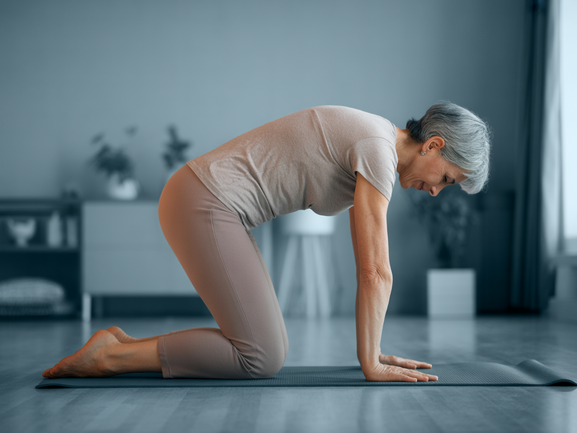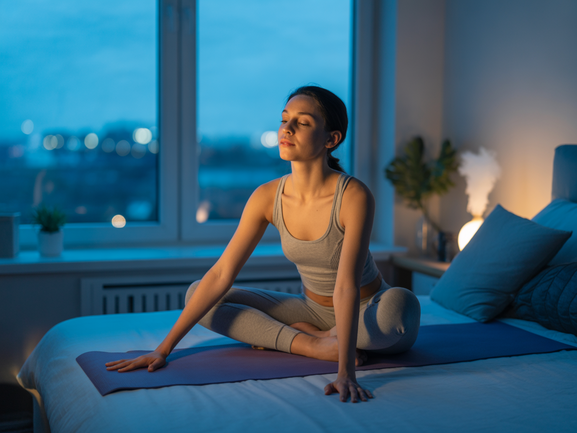Yoga for Back Pain: A 2025 Guide to Relief and Strength
In our modern, sedentary world, back pain has become a near-universal complaint. From long hours spent sitting at a desk to the physical demands of daily life, our spines are under constant stress. If you’re searching for a sustainable, effective solution, you’ve come to the right place. This guide explores how yoga for back pain offers a powerful path to not just alleviate discomfort, but to build a stronger, more resilient back for the long term.
This practice isn’t about achieving perfect, complex postures. It’s a therapeutic approach combining gentle stretches, core strengthening, and mindful breathing to decompress the spine, release deep-seated muscle tension, and correct the postural habits that contribute to chronic pain. Let’s dive into how you can start your journey toward a pain-free life.
The Science Behind How Yoga for Back Pain Works
Yoga’s effectiveness isn’t just anecdotal; it’s backed by science. When you practice yoga for back pain, you engage in a multi-faceted approach that addresses the root causes of discomfort. It’s a holistic discipline that positively impacts your body’s physical and neurological systems.
Here’s a breakdown of the key mechanisms at play:
- Muscular Elongation and Release: Poses like Child’s Pose and Cat-Cow gently stretch and lengthen tight muscles, especially in the hips, hamstrings, and lumbar region. Tightness in these areas is a primary contributor to lower back strain.
- Core Muscle Activation: Many foundational yoga poses are excellent for activating the deep core muscles, including the transverse abdominis and multifidus. A strong, stable core acts like a natural corset, providing essential support for the spine and improving overall posture.
- Spinal Decompression: Gentle twists and specific stretches create space between the vertebrae, which can help relieve pressure on spinal discs and nerves. This is particularly beneficial for reducing the sharp, radiating pain associated with conditions like sciatica.
- Mind-Body Connection: Through focused breathing (pranayama) and body awareness, yoga helps calm the nervous system. Chronic pain can put the body in a constant state of stress (the “fight-or-flight” response), which leads to muscle tension. Yoga helps shift you into a state of relaxation (“rest-and-digest”), reducing stress hormones like cortisol and altering your perception of pain.
💡 According to a study published by the National Center for Complementary and Integrative Health (NCCIH), a consistent yoga practice can be as effective as physical therapy in reducing chronic lower back pain and improving mobility.
What Are the Main Benefits of Practicing Yoga for Back Pain?
Integrating a consistent yoga practice into your routine offers significant, tangible advantages for your back health and overall well-being. Here are the key benefits you can expect:
- Significant Pain Reduction: Regular practice helps decrease chronic lower back pain, making daily activities more manageable and reducing reliance on medication.
- Increased Flexibility and Mobility: Gentle, sustained stretching lengthens tight muscles and improves the range of motion in your spine and hips, which are often the culprits behind back stiffness.
- Enhanced Core Strength: A stronger core provides better support for your entire spinal column, which is fundamental for improving posture and preventing future injuries.
- Profound Stress Relief: The mindfulness and breathing components of yoga are proven to lower cortisol levels, effectively reducing the stress that causes back muscles to tense up.
- Improved Postural Awareness: By building a stronger connection to your body’s alignment, you can actively correct the slouching and imbalances that contribute to pain throughout the day.
- Better Circulation: The movement and stretching involved in yoga boost blood flow, delivering vital oxygen and nutrients to the muscles and soft tissues of the back, which aids in the healing process.

How to Start with Yoga for Back Pain Safely
Taking that first step can feel intimidating, especially when you’re already in pain. However, a structured and gentle approach ensures you begin safely and effectively. Here’s a step-by-step guide to get you on the mat without fear.
- Consult Your Doctor: Before beginning any new exercise regimen, it’s crucial to get clearance from a healthcare professional, especially if you have a diagnosed condition like a herniated disc or sciatica.
- Find a Beginner-Friendly Program: Don’t jump into an advanced class. Look for resources specifically designed for back pain, like the specialized programs in the Vitalizen App.
- Start with Gentle, Foundational Poses: Begin with restorative poses known to be safe for the spine. The goal is gentle movement, not pushing your limits.
- Prioritize Your Breath: Connect your breath to each movement. Inhale as you lengthen or expand, and exhale as you deepen a stretch or release. This mindful practice is key to releasing tension.
- Listen to Your Body: This is the golden rule of yoga. Avoid any posture that causes sharp, shooting, or sudden pain. If you feel anything beyond a mild stretch, gently back off. The motto is “no pain, all gain.”
- Use Props for Support: Don’t be afraid to use props like blocks, blankets, or bolsters. They can help you maintain proper alignment and make poses more accessible and comfortable.
8 Best Beginner Poses for Back Pain Relief
Here are a few foundational poses to guide your initial practice. Focus on slow, controlled movements and how your body feels. We’ve included detailed instructions to ensure you practice safely.
1. Child’s Pose (Balasana)
Benefit: Gently stretches the lower back, hips, and thighs while calming the nervous system.
How to do it: Start on your hands and knees. Spread your knees wide apart while keeping your big toes touching. Sit back on your heels and fold forward, resting your torso between your thighs. Rest your forehead on the floor and let your arms stretch out in front of you or rest alongside your body. Hold for 5-10 deep breaths.
2. Cat-Cow Stretch (Marjaryasana-Bitilasana)
Benefit: Warms up the spine, improves flexibility, and relieves tension in the neck and upper back.
How to do it: Start on your hands and knees with your wrists under your shoulders and knees under your hips. As you inhale (Cow), drop your belly, lift your chest and tailbone, and look forward. As you exhale (Cat), round your spine toward the ceiling, tuck your chin to your chest, and press the floor away. Flow between these two poses for 10-15 rounds.

3. Supine Twist (Supta Matsyendrasana)
Benefit: Releases tension throughout the spine and can improve digestion.
How to do it: Lie on your back and draw your knees into your chest. Extend your left leg long onto the mat and keep your right knee hugged in. Extend your right arm out to the side. Gently guide your right knee across your body to the left, keeping both shoulders on the floor. Turn your gaze to the right. Hold for 5-8 breaths and repeat on the other side.
4. Bridge Pose (Setu Bandhasana)
Benefit: Strengthens the glutes, hamstrings, and core, which provides better support for the lower back.
How to do it: Lie on your back with your knees bent and feet flat on the floor, hip-width apart. Place your arms alongside your body, palms down. Press into your feet and lift your hips off the floor. Keep your thighs parallel. Hold for 3-5 breaths, then slowly lower down. Repeat 3-5 times.
5. Downward-Facing Dog (Adho Mukha Svanasana) – Modified
Benefit: Creates length in the spine and stretches the hamstrings.
How to do it: From your hands and knees, tuck your toes and lift your hips up and back, forming an inverted V-shape. For back pain, keep your knees generously bent to prioritize a long, straight spine. Press firmly into your hands and let your head hang freely. Hold for 5 breaths.
6. Sphinx Pose (Salamba Bhujangasana)
Benefit: A gentle backbend that strengthens the spine and stretches the chest and shoulders.
How to do it: Lie on your stomach with your legs extended behind you. Place your elbows under your shoulders and your forearms on the floor, parallel to each other. Gently lift your head and chest off the floor, pressing your pubic bone into the mat. Keep your gaze forward. Hold for 5-8 breaths.
7. Knees-to-Chest (Apanasana)
Benefit: Relieves tension in the lower back and massages the abdominal organs.
How to do it: Lie on your back and gently draw both knees into your chest. Hold onto your shins or the backs of your thighs. You can remain still or gently rock from side to side to massage your lower back. Hold for 5-10 breaths.
8. Supine Figure-Four Stretch (Supta Kapotasana)
Benefit: Stretches the piriformis muscle and outer hips, a common source of sciatica and lower back pain.
How to do it: Lie on your back with your knees bent. Cross your right ankle over your left thigh. Reach through your legs and interlace your fingers behind your left thigh. Gently pull the left thigh toward you until you feel a stretch in your right hip and glute. Hold for 5-8 breaths and switch sides.
Which Yoga Pose is Right for Your Back Pain?
Choosing the right poses depends on your specific needs and comfort level. This table provides a quick reference to help you build a practice that works for you.
| Yoga Pose | Primary Benefit | Difficulty Level | Best For |
|---|---|---|---|
| Child’s Pose | Gentle Lower Back Stretch | Beginner | Overall tension relief & rest |
| Cat-Cow Stretch | Spinal Flexibility | Beginner | Morning stiffness |
| Supine Twist | Releasing Spinal Tension | Beginner | Improving mobility |
| Bridge Pose | Strengthening Glutes & Core | Beginner-Intermediate | Supporting the lower back |
| Sphinx Pose | Gentle Spinal Strengthening | Beginner | Counteracting slouching posture |
| Supine Figure-Four | Hip & Piriformis Stretch | Beginner | Sciatica-like pain relief |
Common Mistakes to Avoid When Practicing Yoga for Back Pain
While yoga is incredibly beneficial, incorrect practice can stall progress or even worsen pain. Being aware of these common pitfalls is key to a safe and healing journey.
- Pushing Through Sharp Pain: This is the most critical mistake. A gentle stretching sensation is good; sharp, shooting, or electrical pain is a signal to stop immediately.
- Deep Forward Folds: While hamstring flexibility is important, deep forward folds from a standing position can put excessive strain on the lumbar spine and discs. Opt for modified versions or supine hamstring stretches instead.
- Holding Your Breath: Breath-holding creates tension in the body. Focus on smooth, continuous breathing to help your muscles relax and release.
- Ignoring Core Engagement: Even in stretching poses, maintaining a slight engagement of your core muscles helps protect your lower back from over-arching or strain.
- Inconsistency: Practicing for 10-15 minutes daily is far more effective for managing back pain than one long, intense session per week. Consistency is the foundation of long-term relief.
Your Path to a Healthier Back Starts Now
Integrating yoga and mindfulness into your life is a powerful, proactive step towards lasting back pain relief. Remember to listen to your body, move with intention, and celebrate the small victories along the way. The journey to well-being truly begins with a single, mindful breath.
🎯 Ready to take that first step? Let us guide you. The Vitalizen App | Yoga + Meditation has specialized, easy-to-follow programs designed specifically for back pain relief. Our expert instructors provide modifications for every level, ensuring a safe and effective practice.
💡 Download Vitalizen today and discover how just a few minutes a day can transform your relationship with your back and improve your quality of life.
Frequently Asked Questions About Yoga for Back Pain
Can yoga really help with chronic back pain?
Absolutely. Yoga helps by strengthening core muscles that support the spine, increasing flexibility in tight areas like the hips and hamstrings, and improving posture. Furthermore, the mindfulness aspect reduces the perception of pain and lowers stress, which is often a contributing factor. Many studies, like those published by Harvard Health Publishing, support its effectiveness as a long-term management strategy.
How long before I see results from yoga for back pain?
This varies for everyone. Some people feel immediate relief in flexibility after a single session, while for others, significant pain reduction is a more gradual process over several weeks of consistent practice. Consistency is more important than intensity. A short, daily practice of 10-20 minutes is often more effective for long-term healing than one long session per week.
What if I’m too stiff or in too much pain to start yoga?
This is a very common concern. The key is to start with extremely gentle and modified poses. Child’s Pose, gentle Cat-Cow, and even just mindful breathing in a comfortable seated or lying position are perfect starting points. The Vitalizen app offers a “Gentle Beginnings” program for this exact situation. Always listen to your body and never push into sharp pain. The goal is to soothe, not strain.
Are there specific yoga poses to avoid for back pain?
Yes. If you have acute back pain, especially with disc issues like sciatica, it’s wise to avoid deep, unsupported forward folds (like touching your toes from standing), intense backbends without proper warm-up, and aggressive, fast-paced twisting. Focus on poses that create length and support. It’s always best to consult with a healthcare provider or a qualified yoga instructor. For further questions, feel free to reach out to our team through our contact page.
When is the best time of day to practice yoga for back pain?
The best time is whenever you can be consistent. Many people find a gentle morning practice helps relieve stiffness from sleep and sets a positive tone for the day. An evening session can help release tension accumulated from daily activities and promote more restful sleep. Listen to your body’s rhythm and choose a time that feels sustainable for your schedule.



